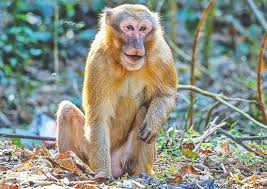In the Satchori National Park of Habiganj, there is a rare species of monkey, the `Assami monkey,` which has been surviving for several years.
This species is more commonly found in Assam, India, and hence, it has been named the `Assami` monkey.
Apart from Satchori Park, this species is not found anywhere else in Bangladesh.
In the park, the lone monkey can be seen wandering around the student dormitory and restaurant, often alone.
Due to its rare species, it cannot blend with local monkeys or other primates, which is why it is often seen as solitary.
Wildlife experts suggest that the monkey needs a mate.
It has been recommended to bring in some of this species from India or abroad and release them into the forest to assist with breeding.
Locals have noticed that the monkey is often seen sitting alone in a depressed state.
Some people even disturb the monkey by taking pictures, while others are concerned about the potential risks of hunting or illegal trafficking.
Mehdi Hasan, a local forest officer, mentioned that the Assami monkey moves alone.
He also said there is a possibility it could breed with local monkeys, resulting in hybrid offspring, but it still needs a mate.
The Assamese monkey is a rare and endangered species of mammal, also known as the Assam macaque or the Bhutan macaque. Its scientific name is Macaca assamensis and it belongs to the Cercopithecidae family.
This species is globally considered vulnerable. It is a large monkey, but compared to other monkey species, its tail is quite short.
The length from the nose to the base of the tail is between 51 to 73 centimeters, while the tail itself is 15 to 30 centimeters long.
Males weigh between 10 to 14 kilograms, and females weigh between 10 to 12 kilograms.
The head is large and square, with a wide face that is dark brown to reddish in color.
The fur on the upper body is brown-grey, while the lower fur is a whitish-grey.
The Assamese monkey is a resident of mixed evergreen hilly forests.
They are diurnal, arboreal, and terrestrial creatures, and they tend to be shy.
Normally, they live in groups of 5 to 15, including males, females, and babies. There may be several adult males within the group.
Their diet includes fruits, leaves, flowers, seeds, insects, and small vertebrates.
Despite their forest habitat, there are reports of them raiding crop fields for food in Nepal and India. They communicate with a soft `piew-piew` call.
Breeding takes place from April to June. Female monkeys become capable of reproduction at the age of five.
After a gestation period of 158 to 170 days, they give birth to a single baby. Their lifespan is around 10-12 years.





























-20251218165258.jpeg)

-20251216090625.jpeg)



-20251216054240.jpeg)



